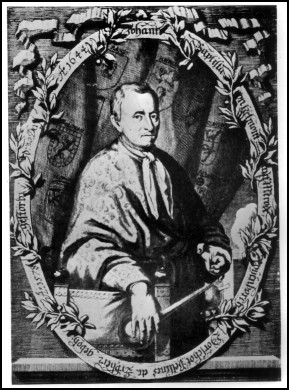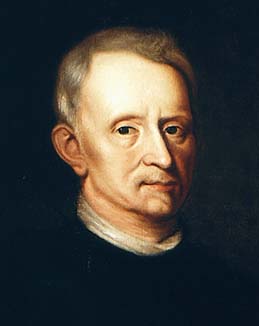<Back to Index>
- Chemist Jan Baptist van Helmont, 1579
- Painter John Singer Sargent, 1856
- President of the Reichstag Hermann Wilhelm Göring, 1893
PAGE SPONSOR


Jan Baptist van Helmont (bapt. 12 January 1579 – 30 December 1644) was an early modern period Flemish chemist, physiologist, and physician. He worked during the years just after Paracelsus and iatrochemistry, and is sometimes considered to be "the founder of pneumatic chemistry". Van Helmont is remembered today largely for his ideas on spontaneous generation, his 5 year tree experiment, and his introduction of the word "gas" (from the Greek word chaos) into the vocabulary of scientists.
Van Helmont was the youngest of five children of Maria (van) Stassaert and Christiaen van Helmont, a public prosecutor and Brussels council member, who had married in the Sint - Goedele church in 1567. He was educated at Leuven, and after ranging restlessly from one science to another and finding satisfaction in none, turned to medicine. He interrupted his studies, and for a few years he traveled through Switzerland, Italy, France, and England.
Returning to his own country, van Helmont obtained a medical degree in 1599. He practiced at Antwerp at the time of the great plague in 1605. In
1609 he finally obtained his doctoral degree in medicine. The same year
he married Margaret van Ranst, who was of a wealthy noble family. Jan
and Margaret lived in Vilvoorde, near Brussels, and had six or seven children. The
inheritance of his wife enabled him to retire early from his medical
practice and occupy himself with chemical experiments until his death
on the 30th of December 1644. Van Helmont is regarded as the founder of pneumatic chemistry, as he was the first to understand that there are gases distinct in kind from atmospheric air. The very word "gas" he claimed as his own invention, and he perceived that his "gas sylvestre" (carbon dioxide) given off by burning charcoal, was the same as that produced by fermenting must, which sometimes renders the air of caves unbreathable. For Van Helmont, air and water were the two primitive elements. Fire he explicitly denied to be an element, and earth is not one because it can be reduced to water. Van Helmont was a man of contradictions. On the one hand, he was a disciple of Paracelsus (though he scornfully repudiated his errors as well as those of most other contemporary authorities), a mystic and alchemist. On the other hand, he was touched with the new learning based on experiment that was producing men like William Harvey, Galileo Galilei and Francis Bacon. Van Helmont was a careful observer of nature;
it can be inferred that from his analysis of data gathered in his
experiments suggested he had a concept of the conservation of mass. He
performed an experiment to determine where plants get their mass. He
grew a willow tree and measured the amount of soil, the weight of the
tree and the water he added. After five years the plant had gained
about 164 pounds. Since the amount of soil was basically the same as it
had been when he started his experiment, he deduced that the tree's
weight gain had come from water. Since it had received nothing but
water and the soil weighed practically the same as at the beginning, he
argued that the increased weight of wood, bark and roots had been
formed from water alone. However, this "deduction" is incomplete, as a
large proportion of the mass of the tree comes from atmospheric carbon
dioxide, which, in conjunction with water, is turned into carbohydrates via photosynthesis. Although a faithful Catholic, he incurred the suspicion of the Church by his tract De magnetica vulnerum curatione (1621), which was thought to derogate from some of the miracles. His works were collected and edited by his son Franciscus Mercurius van Helmont and published by Lodewijk Elzevir in Amsterdam as Ortus medicinae, vel opera et opuscula omnia in 1648. "Ortus medicinae" was based on, but not restricted to, the material of Dageraad ofte Nieuwe Opkomst der Geneeskunst ("Daybreak,
or the New Rise of Medicine"), which was published in 1644 in Van
Helmont's native Dutch. In his son Frans's own writings (e.g. Cabbaiah Denudata (1677) and Opuscula philosophica (1690)) mystical theosophy and alchemy appear in confusion. Over and above the archeus, he believed that there is the sensitive soul which is the husk or shell of the immortal mind. Before the Fall the
archeus obeyed the immortal mind and was directly controlled by it, but
at the Fall men also received the sensitive soul and with it lost
immortality, for when it perishes the immortal mind can no longer
remain in the body. In addition to the archeus,
which he described as "aura vitalis seminum, vitae directrix", van
Helmont believed in other governing agencies resembling the archeus
which were not always clearly distinguished from it. From these he
invented the term blas, defined as the "vis motus tam alterivi quam localis." Of blas there
were several kinds, e.g. blas humanum and blas meteoron; the heavens he
said "constare gas materiâ et blas efficiente."
Van Helmont wrote extensively on the subject of digestion. In Oriatrike or Physick Refined (1662, English translation of Ortus medicinae ...), van Helmont addressed earlier ideas on the subject, such as that food
was digested due to the body's internal heat. If such was the case, van
Helmont argued, how could cold blooded animals live? His own opinion
was that digestion was aided by a chemical reagent, or "ferment",
within the body, such as inside the stomach. Harré suggests that
in this way, van Helmont's idea was "very near to our modern concept of
an enzyme." van Helmont proposed and described six different stages of digestion.
In 2003, the historian Lisa Jardine claimed a recently discovered portrait represented Robert Hooke. However, Jardine's hypothesis was disproved by William Jensen of the University of Cincinnati and by the German researcher Andreas Pechtl of Johannes Gutenberg University of Mainz. The portrait in fact depicts Jan Baptista van Helmont.